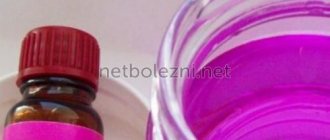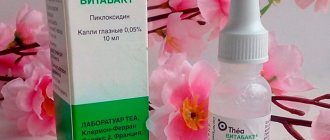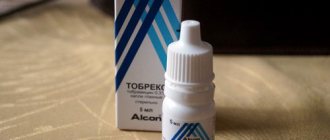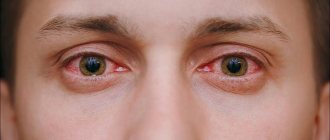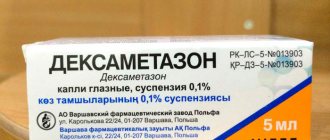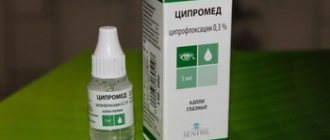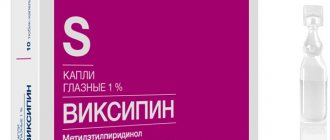Conjunctivitis is a very common ophthalmological disease. It is characterized by inflammation of the conjunctiva, the mucous membrane that covers the inner surface of the eyelids and sclera. Eye drops are an effective pharmacological form that allows you to actively act on inflamed tissues with conjunctivitis.
In this article
- What to put in your eyes for conjunctivitis?
- What medications can be used for viral conjunctivitis?
- What should I use in my eyes for bacterial conjunctivitis?
- Treatment of allergic conjunctivitis with drops
- How to put eye drops correctly?
- Is it possible to choose eye drops yourself?
Making a choice
Conjunctivitis has varieties depending on the cause that caused it. Accordingly, drops for treatment are divided into several groups.
Inflammation of the conjunctiva has the following types:
- Infectious conjunctivitis. Appears due to exposure to viruses.
- Bacterial. Inflammation of the conjunctival membrane caused by a bacterial agent (staphylococci, streptococci).
- Allergic conjunctivitis. Inflammation of the mucous membrane of the eye develops as a result of the body's reaction to an allergen (poplar fluff, wool). Treatment should begin with eliminating the irritant.
Infectious and bacterial conjunctivitis are contagious, so when the first signs appear, you need to take precautions to avoid infecting your household and other people.
Diclofenac
Diclofenac eye drops are an affordable and effective product in its price category. The drug does an excellent job of treating conjunctivitis and relieving eye inflammation. Drops are also used for pain relief after various injuries and operations.
The main active ingredient is diclofenac sodium. Due to the fact that it is instantly absorbed into the blood, it provides quick and effective help. The drug has some side effects, so to avoid problems, you must carefully study the instructions and follow them strictly.
You can instill no more than 5 times a day, 1-2 drops, otherwise itching and, worst of all, swelling of the face are possible. If you use contact lenses, then while using drops you need to completely abandon them. After you have opened the bottle, you can use the drug for a month.
The average cost of the drug is 70-100 rubles.
Drops for conjunctivitis in adults
Before treating conjunctivitis, it is necessary to find out the reason that triggered its development. Drops for instillation differ greatly in their composition. So, to eliminate conjunctivitis caused by bacteria, antibiotics are used; for the infectious form, drugs with antiviral effects are used. The allergic form is treated with antihistamines.
Treatment of viral disease in men and women
To eliminate viral conjunctivitis in adults, the following medications help:
- Oftalmoferon. Good drops with antiviral, antihistamine, immunomodulatory effects. They are characterized by rapid action, eliminating the symptoms of the disease in the shortest possible time. In the first days, Oftalmoferon is instilled up to 8 times a day. As soon as the symptoms begin to subside, the number of instillations is gradually reduced.
- Ciprofloxacin. Broad-spectrum antibiotic. It is dripped drop by drop every 2 hours for 2-3 days. For the next 5 days, instillations are done every 4 hours. Do not use in children under one year of age.
Antibacterial drops
The most effective drops don't have to be expensive. There are many inexpensive but effective drugs:
- Levomycetin. The drug is very popular due to its low cost and high effectiveness. These eye drops are recommended to be used for 3 days, even without a doctor’s prescription, for different types of conjunctivitis. Levomycetin should not be taken during pregnancy or newborn children.
- Tobrex. Eye drops that successfully relieve inflammation of the conjunctiva caused by Escherichia coli, Pseudomonas aeruginosa, and staphylococci.
- Albucid. Inexpensive drops, the use of which is approved for adults and children. Available in different concentrations of the active substance (20% and 30%). The disadvantage of Albucid is its rather aggressive effect on the eye. Many people experience itching, burning, and swelling of the eyelids when using it. In this case, you can replace Albucid with Tsipromed.
- Tsiprolet. An antibacterial drug that contains the antibiotic ciprofloxacin. Tsiprolet is effective against spirochetes, gonococci, and Klebsiella. Not recommended for use in pregnant, lactating women, children under 2 years of age, patients with viral keratitis, patients with hypersensitivity to fluoroquinolones and specifically to ciprofloxacin. An analogue of Tsiprolet is Tsipromed.
- Phloxal. Antibacterial drops with antiviral effect. The active substance is Ofloxacin, which effectively fights conjunctivitis caused by coccal infection, Pseudomonas aeruginosa, and fungi. Floxal also causes side effects, such as tearing, itching, burning, temporary decreased vision, which is completely restored after 30 minutes. It is prohibited to instill Floxal in pregnant and lactating women.
- Taufon. An effective drug whose main active ingredient is taurine. Taufon quickly eliminates numerous pathogenic bacteria from the surface of the eye. Taufon is prescribed for the spread of conjunctivitis to the cornea of the eye. The number of instillations and dosage of the drug is calculated strictly individually.
- Nevanak. The active substance is nepafenac, which has an anti-inflammatory effect, eliminates itching and swelling. Long-term use of Nevanac leads to decreased vision. The use of an ophthalmic agent in children is prohibited; it is prescribed after 18 years of age.
- Tobradex. Powerful combined drops with anti-inflammatory and antibacterial properties.
- Okomistin. A modern drug with an antiseptic in its composition.
- Sofradex. The drops contain framycetin sulfate (destroys harmful bacteria).
- Signicef. Antibacterial drops of the fluoroquinolone group. They are highly efficient. After instillation, they remain in the tear film for a long time, providing a therapeutic effect. May cause severe burning.
Eye drops against allergic conjunctivitis
Elimination of allergic conjunctivitis begins with limiting contact with the allergen. Then drops are prescribed, which should eliminate redness, watery eyes, and swelling of the eyelids.
Such drugs are:
- Allergophthal. An ophthalmic agent containing naphazoline hydrochloride and antazoline phosphate. It has a vasoconstrictor effect (constricts blood vessels, thereby eliminating redness, pain, and swelling of the eyelids) and has an antihistamine effect. The drug is not prescribed to children under 6 years of age who have high blood pressure or heart disease.
- Cromozil. An antihistamine based on tetrazoline hydrochloride (a vasoconstrictor). Prescribed for adults and children.
- Nafcon. The composition contains naphazoline hydrochloride (vasoconstrictor) and pheniramine maleate (antihistamine). These eye drops are recommended for use from the age of twelve.
- Dexamethasone. A potent drug with the same active substance.
- Sofradex . In addition to the antibacterial effect, these drops perfectly relieve inflammation and allergic swelling, thanks to the dexamethasone component.
For allergic form
Allergic conjunctivitis drops do not cure in the literal sense of the word. They are designed to eliminate unpleasant symptoms: itching, burning, swelling, redness of the eyes. Treatment of any allergy consists first of all in identifying the allergen and stopping contact with it. If this is not possible (for example, in the case of hay fever - a reaction to plant pollen in the air), symptomatic remedies come to the rescue.
We list the best drops for allergic conjunctivitis.
Allergodil
An antiallergic drug that relieves the entire complex of symptoms: itching, redness, swelling of the eyelids. It works locally, but is still not recommended for children under 4 years of age, pregnant or breastfeeding women. Sometimes after instillation, blurred vision occurs, which lasts very briefly, and a sensation of a foreign body in the eye, which also quickly passes.
Price: 410–480 rubles.
Cromohexal
Cromones are substances that have a pronounced local antiallergic effect. The active substance in Cromohexal is cromoglycic acid, which stabilizes mast cell membranes and relieves allergy symptoms. It is a transparent yellowish solution that does not cause discomfort during instillation.
Price: 150–370 rubles.
Visine
Visine relieves severe redness of the eyes, but does not have an antiallergic effect. It is prescribed specifically to relieve severe conjunctival hyperemia - one of the most pronounced symptoms of allergy on the part of the visual organs. Prescribed as an aid in the fight against allergic inflammation.
Cost of Visine: 230–290 rubles.
Among others, Systane is good at soothing eyes irritated by allergens. Cost of Systane drops: 500 rubles.
Drops for the treatment of childhood conjunctivitis
Babies are not protected from inflammation of the mucous membrane of the eye. The ophthalmologist should decide which drops to treat conjunctivitis in a baby, since the treatment regimen is drawn up for each specific case.
For allergic conjunctivitis
Allergic conjunctivitis appears due to the action of a certain irritant on the human body. In each specific case, an individual selection of medications is necessary. The age of the little patient also makes adjustments.
The most effective antihistamine drops:
- Allergodil. Designed for children over 4 years old. It has virtually no contraindications and has a long-lasting effect.
- Nedocromil (Tailed Mint). Prescribed to children from 2 years of age mainly to relieve itching. The drug is easily tolerated by children, as side effects are extremely rare.
- Spersallerg. Drops based on tetrazoline chloride (vasoconstrictor) and antazoline hydrochloride (antihistamine). The drug is prescribed for the treatment of allergic conjunctivitis in children over 2 years of age. Sometimes it is possible to use Spersaller earlier in consultation with a pediatric ophthalmologist.
- Garazon. Drops based on the antibiotic gentamicin and the corticosteroid beclamethasone. Approved for use in children over 2 years of age.
- Okumetil. The drug contains naphazoline (vasoconstrictor) and diphenhydramine (antihistamine), zinc sulfate (antiseptic). Approved for use from the age of two.
Read in a separate article: The best eye drops for the treatment of blepharitis in adults and children
Eye drops for viral conjunctivitis in children
Typically, viral conjunctivitis develops on only one side at first. But children often begin to touch the sore eye, rub it, and then the other eye, so they can spread the infection to the second organ of vision. Instillation into both eyes at once will help to avoid this.
How much, when and what eye drops to take for children is determined by a pediatric ophthalmologist. The best means are:
- Aktipol. The medicine is suitable for adults and children. Drop 1-2 drops 4-8 times a day. After signs of inflammation disappear, treatment continues for at least another week.
- OftanIdu. Popular drops that can be used from the age of two. Instillations begin every hour during the day and every two hours at night. After eliminating the symptoms, to consolidate the result, it is necessary to drip OftanIda three times a day for another week.
For childhood bacterial conjunctivitis
Today, pharmacies sell high-quality and inexpensive drops for conjunctivitis caused by bacteria.
These include:
- Levomycytin drops . The active substance of the drug quickly blocks the production of proteins by bacteria, which stops the spread of infection. Used as instillations 2 times a day to get rid of purulent conjunctivitis in the initial stage in children over 2 years old.
- Sulfacyl sodium . The active substance of this antimicrobial drug is sulfacetamide, which suppresses the proliferation of pathogenic microflora. In acute conjunctiva, sodium sulfacyl is one of the first to be used.
- Tobrex. Antibacterial drops, the active ingredient of which is tobramycin, which actively destroys a large number of bacteria. It has side effects such as swelling and redness of the conjunctiva.
- Dancil. The basis of the medicine is Ofloxacin. This is an antibiotic that kills most bacteria. The drug is maximally concentrated in the tear fluid after 4 hours.
- Ciprofloxacin. Broad-spectrum antibacterial drug based on fluoroquinolones. Copes well with pathogenic microflora, preventing it from multiplying. Effectively eliminates some gram-positive microorganisms (staphylococci, staphylococci, enterococci) and destroys absolutely all gram-negative pathogens.
- Lomefloxacin (Lofox). Drops for conjunctivitis based on the antibiotic fluoroquinolone. They cope with most gram-positive and gram-negative pathogens that cause inflammation of the conjunctival membrane.
- Phloxal. Perhaps the best antibacterial drops that work well against streptococci, Klebsiella, and spirochetes. They begin to have an effect 10 minutes after instillation, and the therapeutic effect lasts for 6 hours. Floxal has virtually no side effects.
- Framycetin. When deciding which drops are better, you should pay attention to this powerful antibacterial and bactericidal agent. Due to the penetration of the active substance through the bacterial membrane, Framycetin prevents them from multiplying.
- Tsiprolet (analogue – Tsipromed). You can carry out instillations in very young children (up to a year), instilling them every 2 hours for a week. After this, the number of instillations is halved.
- Vitabact. The drug is well tolerated and has strong antiseptic properties. It is prescribed, as a rule, when other drops have not given the desired results.
Other medicines
There are other medications for conjunctivitis. The choice, as well as the method of administration of the drug, is within the competence of the attending physician.
The following drugs have been developed for the treatment of conjunctivitis:
- Ointment: effectively complements therapy if placed behind the lower eyelid at night. May contain an antibiotic (for example, Tetracycline, Floxal) or antiviral components (Acyclovir, Bonafton).
- Tablets: Oral medications are prescribed strictly by a doctor. For example, in some forms of bacterial conjunctivitis, systemic use of a broad-spectrum antibiotic (Levofloxacin, Amoxicillin) is prescribed. For allergies, the doctor prescribes an antihistamine taken orally (Claritin, Zyrtec, Erius).
To prevent conjunctivitis, there are also drops used in adults. These are moisturizing preparations for a risk group: those who wear contact lenses often experience dry eyes. By drying out, the mucous membrane becomes vulnerable to viruses and bacteria, and is also more sensitive to allergens. A hydrated and healthy conjunctiva more easily resists microbial attacks and adverse environmental factors.
Drops for conjunctivitis are an effective remedy that is selected by an ophthalmologist taking into account the specifics of the disease.
How to use drops correctly?
Many people do not pay enough attention to the process of instilling medicine into the eyes. As a result, the drops simply flow out and do not have the desired effect.
The rules of instillation are not so complicated:
- Before dripping the drug, you should read the instructions for it;
- immediately before instillation, you should thoroughly wash your hands with antibacterial soap and dry them;
- if lenses are used, it is better to remove them;
- if a regular pipette is used, the required amount of medicine is taken into it (this is not required for a dropper bottle);
- you need to throw your head back a little, pull down the lower eyelid with your finger, roll your eyes and drop the required number of drops of medicine into the resulting pocket;
- close your eye, press the corner of your eyelid against the wall of your nose with your finger;
- remove any remaining medication with a cotton pad;
- sit with your eyes closed for 3 minutes.
How to use eye drops correctly
It is best for two people to instill eye drops for conjunctivitis in children (especially small ones): one should drip, the other should hold the baby so that the medicine does not leak out.
Use of medications
First of all, it must be said that eye drops for conjunctivitis should be prescribed by an ophthalmologist. It happens that a patient, feeling unpleasant symptoms, goes to the pharmacy and asks the pharmacist for the cheapest drops for conjunctivitis, which do not help him. Not because the price is low, but because the drug was chosen incorrectly and does not act on the cause of the disease.
You need to be especially careful when choosing eye drops against conjunctivitis during pregnancy, since not all medications are approved during this crucial period. The doctor will determine the cause of the inflammation, and then prescribe exactly the drops that are suitable in your case.
For treatment to be effective, follow these rules:
- first, rinse the eye from mucus and pus with a swab dipped in a decoction of medicinal plants (for example, chamomile) or a solution of furatsilin;
- then drip the drops into the conjunctival sac, retracting the lower eyelid;
- blink, massaging the eyelid with your fingers, distributing the solution.
Some drops may cause an unpleasant reaction after instillation. This is due to the fact that the inflamed mucosa becomes more sensitive, it reacts sharply to the active component. Sometimes side effects such as stinging, burning and pain in the eyes occur.
You just have to endure these unpleasant sensations and use the drug as often as the doctor prescribed. Only by following all the recommendations can you count on a quick effect from the use of the drug.
Features during pregnancy
The difficulty of treating inflammation of the eye mucosa in pregnant women is that it is impossible to drip into the eyes for conjunctivitis the same drugs that are used to treat other adults. At the beginning of pregnancy, they are limited to the use of local agents that do not penetrate the blood, but their choice is very limited.
In subsequent trimesters, your doctor will prescribe most of the medications prescribed to adults. The exception is medications with glucocorticoids, hormones, and heavy metal salts. The doctor decides which drops to use for conjunctivitis during pregnancy. All medications must be strictly coordinated with him and not exceed the indicated dosage.
During pregnancy, the following eye drops are prescribed: Albucid, Tobrex, Vigamox, Tebrofen, Oftalmoferon.
Ciprofloxacin
The most popular and frequently prescribed drug in the treatment of conjunctivitis is Ciprofloxacin eye drops, which have a wide spectrum of action. The composition includes an antibiotic, so in most cases the drops do the job perfectly.
The drug Ciprofloxacin has virtually no contraindications and does not cause allergic reactions. What is also important is that Ciprofloxacin has no particular odor and does not cause burning of the eyes.
The big advantage of the drug is its low price and high efficiency. Already in the first 2 days, many note improvement. And the complete disappearance of the disease occurs within 4-7 days. It is very convenient that the package contains a sterile pipette, with which the drug can be easily dosed.
The price of drops varies around 30-50 rubles.
Prevention
Inflammation of the mucous membrane of the eye is much easier to prevent than to subsequently treat acute or chronic conjunctivitis. Simple rules will help you avoid it:
- use only your own hygiene items;
- wash your hands frequently using antibacterial soap;
- reduce touching your hands to your eyes;
- after visiting the pool or swimming in other public places, you should rinse your eyes with a solution of furatsilin or drip antimicrobial drops for prevention (for example Albucid);
- strengthen your immune system.
Conjunctivitis is an unpleasant and dangerous disease that is fraught with numerous complications. To treat it, only those medications prescribed by an ophthalmologist should be used. After all, for each specific type of disease it is necessary to select appropriate drops against conjunctivitis.
Only with the correct selection of medication and following the rules of instillation will it be possible to eliminate inflammatory processes in the mucous membrane of the eye.
Author of the article: Bakhareva Elena Sergeevna, specialist for the website glazalik.ru Share your experience and opinion in the comments.
Tsiprolet
Also one of the most effective and relatively cheap means is Tsiprolet. It is an antimicrobial drug that has a wide spectrum of action and eliminates inflammation in the shortest possible time.
If you strictly follow the instructions and instill them every 5 hours, then after 3-5 days there will be no trace of conjunctivitis.
One bottle is enough for the full course of treatment.
The only unpleasant phenomenon when using the drops is a burning sensation in the eyes. One of the advantages is that Tsiprolet has a convenient bottle that allows you to dose the drug correctly; the drops are produced in a glass bottle.
The eye drops are reasonably priced. Drops cost 50-60 rubles.
How to deal with bacteria and viruses
Eye inflammation in children requires special treatment. Eye drops are the most suitable, because they can be administered even to a child up to one year old. They are prescribed by a doctor depending on the type of conjunctivitis.
What products fight best against pathogenic bacteria?
Here is a list of drops that doctors can prescribe against bacterial conjunctivitis:
- Albucid. It is prescribed against the disease most often, because the spectrum of action is quite wide: all types of bacteria, chlamydia, accinomycetes. Its price is low, and the product can be used even for children of the first year of life. It is also recommended to drip this drug into the nose. Disadvantages include a possible burning sensation and, occasionally, redness and itching.
- Fucithalmic. It also helps against various types of bacteria and can be used for children of all ages. The only contraindication is hypersensitivity to the components, in particular to fusidic acid. If after a week of use the results are not noticeable, this medicine should be replaced with another one.
- Ciprofloxacin. Has a wide range of effects. It can only be used by children after they reach one year of age.
- Levomycetin. Also refers to antibiotics for wide use. This product does not sting the eyes, but individual intolerance is possible. Contraindicated for children under two years of age.
- Phloxal. The main active substance here is ofloxacin, which has extremely strong antibacterial properties. This antibiotic does not cause eye irritation and is suitable for treating children of any age, including infants. The disadvantages of this remedy against conjunctivitis include the rather high cost and the fact that after opening the drug can be stored for only a month and a half.
- Tobrex. The main active ingredient (tobramycin) copes well with a variety of bacteria, including streptococci and staphylococci. Does not irritate the eyes. Suitable for children of different ages. The disadvantages include the possibility of an allergic reaction and the rather high cost of the drug.
- Vitabact. Has a wide spectrum of antimicrobial action. It fights not only against bacteria, but also some viruses and most fungi. Treatment is carried out for ten days. The only contraindications are hypersensitivity to the components.
There is also a list of popular drugs for the treatment of viral conjunctivitis.
The following eye drops are suitable for this disease:
- Interferon. This product not only copes well with viruses, but also improves the protective properties of the eyes. It is usually offered in pharmaceutical retail outlets in powder form. Its cost is low. To obtain drops, the powder must be diluted with water. You can store the prepared product for no longer than two days in the refrigerator. The disadvantages include the following property of the drug: with prolonged use it ceases to give a positive result.
- Oftalmoferon. This remedy helps with such conjunctivitis, while simultaneously relieving allergic reactions and strengthening the immune system. It fights well against external symptoms - itching, swelling, redness. This is important, because with conjunctivitis the baby constantly tries to scratch his eyes, which causes the risk of additional infection. You can take the drug until complete recovery without reducing the effect. There are no side effects. The only negative is that after opening the package the shelf life of the drug is only 30 days.
- Florenal. The high therapeutic effect allows you to quickly cure viral conjunctivitis. For children, take a 0.1 percent solution. The only side effect is a slight burning sensation after instillation.
- Tebrofen. Used to combat the herpes virus in children. It is very effective, but may cause a burning sensation.
- Oftan I'm coming. Helps with superficial viral keratitis and conjunctivitis caused by the herpes virus. The product is extremely effective, but has contraindications. Thus, its components can cause an allergic reaction, as well as itching and burning in the organs of vision. Children under two years old should not use such drops.
- Aktipol. Also very good for healing conjunctivitis. It has antiviral, immunomodulatory and antioxidant effects. Occasional use of the product can cause a local allergic reaction and hyperemia.
- Dexamethasone. The drug has a rapid effect on inflamed areas and serious antiviral properties. With the help of these drops, inflammation can be relieved in a matter of hours. But it is not recommended to use Dexamethasone for longer than 14 days.
Floxal has a wide range of effects and can help not only with bacterial but also with viral conjunctivitis. Tobrex also helps with both types of disease.
Side effects
The use of drops may be accompanied by side effects caused by the body's individual reaction to the composition of the drug or the presence of chronic eye diseases, which manifest themselves in the form of:
- temporary visual impairment;
- itching and burning that goes away after 5-10 minutes;
- watery eyes or dry mucous membranes;
- redness of the conjunctiva;
- crystalline deposits in the corners of the eyes;
- sensation of a foreign object under the eyelid;
- thinning of the cornea and sclera;
- damage to the optic nerve;
- increased intraocular pressure (when using drugs with glucocorticosteroids for more than 7-10 days);
- superficial damage to the corneal epithelium;
- development of glaucoma (effect from long-term use of drugs with glucocorticosteroids);
- headache;
- unpleasant taste in the mouth, nausea;
- disturbances of psychomotor reactions and coordination (with frequent use of antiallergic drugs with histamine receptor blockers, especially in combination with the use of allergy pills);
- increased blood pressure, tachycardia.
If drops for conjunctivitis containing antibiotics or glucocorticosteroids are used simultaneously with the use of other types of antibiotic tablets, the likelihood of side effects increases significantly.
How to put eye drops correctly
- Prepare two sterile wipes.
- Wash your hands thoroughly or treat them with an antiseptic.
- Shake the bottle with drops several times.
- Open drops.
- Throw your head back.
- Pull the lower eyelid down.
- With your other hand, turn the bottle of medicine vertically downwards and place the required number of drops into the conjunctival sac behind the lower eyelid, gently pressing the bottom of the bottle with your fingers.
- Release your eyelid and close your eye.
- Place a sterile napkin over the closed eye.
- Gently press the inner corner of your eye with your finger and hold for a couple of minutes.
- Repeat the procedure for the other eye.
- Close the bottle.
- If you accidentally exceed the number of drops, you can rinse your eye with water.
- Soft lenses are not recommended during the course of treatment.
- Lenses can be put on fifteen minutes after instillation.
- It is not recommended to drive or operate hazardous equipment for half an hour after the procedure.
Medicines to combat fungal conjunctivitis
Today, it is difficult to find ready-made antifungal drops on the pharmaceutical market. This is due to the fact that fungal eye infections are quite rare. As a rule, drops for their treatment are prepared manually by diluting powder or tablets. The most commonly used antifungal drugs are Amphotericin B, Nystatin, Miconazole, and Fluconazole.
Antiseptic eye drops are widely used to combat fungal conjunctivitis. Most of them are capable of inhibiting the activity of harmful fungi and curing the disease. As a rule, doctors prescribe Okomistin or Vitabact to their patients.
Rules to follow during the treatment process
When treating conjunctivitis in children, the following rules must be observed:
- The bottle cannot be used to treat several people. This contributes to the spread of infection, especially with viral eye inflammation.
- Do not touch the surface of the child’s eyes, eyelids or face with the dropper while administering the solution.
- If your child wears contact lenses, they must be removed before the procedure. Some drops can be used without removing the lenses.
- If an ointment is prescribed along with the drops, the medicinal solution is used first. When using several types of drops, they must be used alternately, observing the intervals prescribed by the doctor.
- Before treatment, remove purulent and mucous eye discharge. To do this, use sterile swabs moistened with Furacilin solution.
What drops should I buy if my child’s eyes suffer from allergic inflammation?
The symptoms of allergic conjunctivitis are quite characteristic, so that parents will be able to determine that their child is affected by such an illness. The patient suffers from unbearable itching, pain, and mild swelling of the conjunctiva. In this case, to alleviate the condition, you can use the following drops:
- Azelastine (Allergodil). Suitable only for children over 4 years old. Has antiallergic and antihistamine effects. It must be instilled into the eyes, 1 drop at a time. morning and evening until the symptoms of the disease completely disappear. According to indications, the dose can be increased to 4 r. per day. Allergodil can be purchased at a price of 320 rubles;
- Opatanol. It is allowed to be used for long-term treatment and causes virtually no side effects. The instructions allow the use of these drops from 3 years of age (1-2 drops, no more than 3 times a day). The interval between such manipulations should not exceed 8 hours. Pharmacies will offer you this product for 400-450 rubles;
- Levocabastine. Promptly relieves the symptoms of allergic conjunctivitis. Can be used by children from 12 years of age. The number of instillations per day is 2 times, 1 drop. (in difficult cases - 3-4 drops). Before starting the procedure, the bottle should be shaken, avoid touching the eyelids with the pipette. Cost – from 250 rubles;
- Lecrolin. Its main component is cromoglycic acid. This remedy (as well as Tobrex) can be used to treat allergic conjunctivitis in newborns and children under 4 years of age. Costs 130 rubles.
If you have children in your family, be prepared to encounter conjunctivitis. It is hardly appropriate to buy drops in advance: if necessary, you will always find them in any pharmacy. But still, you should not be careless about the treatment of this disease, because we are talking about vision. Therefore, take your child to an ophthalmologist (especially if he is not yet a year old) - this way you are guaranteed to overcome inflammation of the conjunctiva without consequences.
Causes of eye conjunctivitis in children aged 2 years
Why are children as young as two years old susceptible to conjunctivitis? 2 years is a period of active learning about the world around us. And if young children study objects and phenomena with the help of an adult, then at 2 years old they strive for independence. Kids want to touch, pick up and taste everything. Also, at the age of 2, many children begin to attend children's groups (kindergarten, early development schools, clubs, and so on).
All this leads to inevitable close contact with pathogenic microflora. Causes of conjunctivitis include :
- Bacteria;
- Viruses;
- Fungi;
- Allergens.
Predisposing factors (what contributes to the active activity of pathogenic microbes) for the development of conjunctivitis in children aged 2 years are:
- Sandbox games;
- Child hypothermia;
- Contact of the mucous membranes of the eyes with the child’s dirty hands (low level of hygiene culture in children aged 2 years);
- Contact with other people's toys, personal hygiene items, etc.;
- The impact of allergens on the body. At this age, the child’s body is extremely sensitive to foreign agents. As a rule, it is at the age of 2 that many parents transfer the child to the common table and/or expand his menu. At the same time, there is a high probability of developing allergies to certain products. In addition, allergens include dust, animal hair, household chemicals, perfumes and others. Children aged 2 years are more likely to experience allergic reactions.
It should be noted that conjunctivitis develops in children with weakened immune systems.
This is facilitated by:
- Fatigue;
- Poor nutrition;
- Stress;
- Teething, which was quite difficult;
- Difficult social and living conditions;
- Frequent illnesses.
Rules for using eye drops
During the treatment of conjunctivitis, you must carefully observe the rules of personal hygiene. It is also advisable to stop wearing contact lenses for a while - they will irritate the eyes and aggravate the course of the disease. For viral inflammation, local remedies (drops, eye ointments) are usually sufficient. People with severe fungal and bacterial conjunctivitis are often prescribed systemic tablets.
Tips for using drops:
- before instilling eye drops, you need to thoroughly wash your hands with soap and clean the conjunctival cavity from purulent contents;
- during instillation, you need to carefully ensure that the cap does not touch the eyelids or conjunctiva;
- It is better to store medicines in the refrigerator, and as far as possible from children.
Relatives of the patient need to know that conjunctivitis is a fairly contagious disease. Therefore, a person with eye inflammation needs to provide a separate towel and bed linen. Family members of the patient need to be extremely careful and carefully observe the rules of hygiene.
Levomycetin eye drops
Levomycetin is the cheapest and time-tested remedy for eye inflammation and the treatment of conjunctivitis. The active ingredient is chloramphenicol. Has antimicrobial and antibacterial effects. Excellent fight against various bacteria. The drug is not afraid of gonococci, staphylococci and even E. coli.
This drug is not addictive and in most cases is tolerated without side effects. But there are cases when, with high sensitivity of the eyes, patients complain of tearing and short-term burning of the cornea. The duration of the course depends on the severity of the disease and is usually determined by the doctor. It is recommended to instill 1 drop up to 4 times a day.
The price of the drops, we can say with confidence, is the cheapest of all, 10-30 rubles.
Antiseptics
The task of antiseptics is to physically eliminate the infection in order to prevent the infection from penetrating deep into the body. Wounds, burns and mucous membranes, including the eyes, are treated with an antiseptic. The antiseptic drug destroys almost all types of microorganisms:
- bacterial infection,
- most of the viruses
- fungal infection
- and protozoa.
The advantage of this group of products is that they do not have a systemic effect and are low allergenic, which in turn leads to a small number of contraindications. Since antiseptics have only a local effect, they can be used by pregnant women, lactating women, and newborn children. But, as you know, there are some disadvantages, which is that the drugs have high local aggressiveness, which significantly narrows their range of use.
The most widely used antiseptics for the eyes are:
Okomistin and Vitabact
Indications: Antiseptic eye medications are used in the following cases:
Contraindications to this drug are an allergic reaction or hypersensitivity. If, after using these drops, unpleasant symptoms occur, such as swelling of the tissues surrounding the eyes, sharp pain, lacrimation or painful spasms of the eyelids, you must stop using the drug. |
A universal broad-spectrum agent is Albucid (sodium sulfacyl)
If the question arises: Which eye drops are cheaper, faster and safer?, feel free to choose Albucid.
Sulfacyl sodium (Albucid)20-50 rub. The drug in bottles or pipettes is easy to use, active against most bacteria (gonococci, strepto- and staphylococci, E. coli), suitable for children (including newborns) and pregnant women. Almost the only problem is individual intolerance or allergy to sulfonamides, manifested in redness and itching of the eyelids and conjunctiva. In people over 65, long-term use of albucid can lead to hematopoietic disorders. Also, long-term therapy is not indicated for severe liver or kidney failure. The drug should be prescribed with caution to persons receiving diuretics such as furosemide and patients with type 2 diabetes mellitus treated with sulfonylurea derivatives (Glibenclamide, Gliclazide). The active ingredient of the drug is 20% or 30% sulfacetamide, supplemented with distilled water, sodium thiosulfate and hydrochloric acid. Due to its excellent solubility in water, the active substance simply penetrates into the main media of the eye and can be used for the treatment of purulent bacterial conjunctivitis, corneal ulcers, keratitis, in the complex therapy of blepharitis, barley and for the prevention of blenorrhea (gonococcal eye disease) in newborns. This is the number one remedy for conjunctivitis for children of all ages. Albucid should not be prescribed to patients receiving Methotrexate, Cyclosporine, anticonvulsants, or indirect anticoagulants. |
Phloxal
This drug has proven itself only on the positive side. Unlike many other eye drops, it has a multifaceted effect on the human body. The drops contain active components that kill a large number of viruses and bacteria without affecting vision function.
The frequency of instillation depends on the severity of the disease. It is recommended to use 3 drops up to 5 times a day for severe illness.
Often, ophthalmologists prescribe antimicrobial ointments, such as tetracycline, with this drug. But you should not combine drops and ointments on your own, as this is dangerous. Let the doctor think through the treatment regimen exclusively.
This drug costs 200-220 rubles.
Types of conjunctivitis
Conjunctivitis is an inflammatory lesion of the conjunctiva, which is manifested by congestion of blood vessels (hyperemia) and swelling of the mucous membranes of the eye, swelling and itching of the eyelids, the appearance of pathological mucous or purulent discharge.
Inflammation of the conjunctiva is a fairly common disease; about 40% of all ophthalmological diseases are lesions of the mucous membrane of the eye. This prevalence is facilitated by a large number of reasons that contribute to the development of this inflammation. The main ones are:
- bacteria – staphylococci, streptococci, pneumococci, etc.
In the case of bactericidal infection, it manifests itself as an independent disease.
- viruses – adenoviruses (most often), smallpox, measles, herpetic.
When the body is infected with a virus, conjunctivitis is a secondary manifestation of infection.
It appears most often in cases of general weakening of the immune system and is quite rare.
- chlamydia - microbes.
Chlamydial conjunctivitis affects people who have been diagnosed with chlamydia of the genitourinary tract, and its development is possible in newborns as a result of infection during childbirth from a sick mother. It is not uncommon for chlamydia to develop after visiting public baths or swimming pools.
- non-infectious factors - dust, smoke, various chemicals, pollen and other allergens.
These factors most often cause allergic conjunctivitis, which most often has a seasonal manifestation.
In addition to the main reasons mentioned, inflammation of the mucous membrane of the eye can occur against the background of a severely weakened immune system (for example, with tuberculosis, HIV), various vision pathologies, mechanical trauma to the eye, poor hygiene when wearing contact lenses, dry eye syndrome, etc.
Based on the causes of inflammation, there are 5 main types of disease:
- bacterial – more common in children;
- viral – as a secondary manifestation of infections caused by viruses;
- allergic – seasonal;
- chlamydial – “bath”;
- fungal.
Regardless of the origin, the disease has manifestations characteristic of all its types. Most often this is:
- swelling;
- increased fullness of the blood vessels of the mucous membrane of the eye;
- itching and burning;
- sensation of a foreign body in the eye;
- increased lacrimation;
- increased sensitivity to light.
In addition to the general symptoms, each type of conjunctivitis has specific manifestations, which are more specifically described in the table below.
| Type of conjunctivitis | Specific manifestations |
| Bacterial | Sharply appearing hyperemia of the mucous membrane, swelling of the eyelid, a feeling of “sand” in the eyes, mucopurulent discharge, after sleep - sticky eyelashes, severe itching and burning in the eye area. Most often, one eye is affected, but over time, symptoms appear in the second. Characterized by a high level of infectivity. Transmitted through household items - towels, bed linen, etc. |
| Viral | Herpetic conjunctivitis: photophobia, excessive lacrimation, blepharospasm (involuntary closure of the eyelids), the appearance of watery blisters on the eyelids, as well as their redness and swelling. Adenoviral conjunctivitis: mucous discharge, burning, stinging, feeling of “sand” in the eyes, redness of the conjunctiva and eyelids, increased sensitivity to light, lacrimation. Both eyes are affected at once. It is transmitted through contact with a sick person, through hands, household items, etc. |
| Allergic | Severe itching and burning under the eyelids, increased lacrimation and photosensitivity, mucous discharge, possible development of blepharospasm. Both eyes are affected at the same time. Not contagious. |
| Fungal | Symptoms may vary depending on the type of mycosis that caused the inflammation. |
| Chlamydial | Severe swelling of the eyelids and mucous membranes of the eye, copious discharge of mucus and pus from the conjunctival sac, enlarged lymph node near the auricle. It is highly contagious and spreads quickly through household contact. |
Treatment of all types of disease is based on eliminating the causes of the inflammatory process, as well as relieving unpleasant symptoms. For this purpose, medications are used in the form of solutions injected into the eyes.
